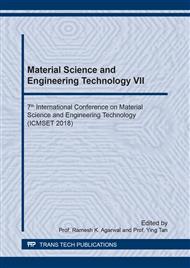p.10
p.15
p.24
p.32
p.38
p.44
p.50
p.55
p.60
Analysis of the Cutting Surface Striation Shape
Abstract:
In the process of abrasive water jet (AWJ) cutting, there will produce a series of striation shape on the cutting surface of target. In this paper, we define such striation as cutting striation shape. The most research of this paper is the force situation and movement trajectory of water jet in the process of cutting. It is deduced by theory that the cutting surface striation shape is circular arc and find that the radius of circular arc is related to cutting velocity, cutting pressure and the property of cutting material. In the experiment, stainless steel 304 and aluminum 6061 were cut by AWJ and the result shows that the shape of the surface striation is arc-shaped in both material surface. At different cutting pressure, for a same material, K_R is a constant value which is only related to the property of cutting material.
Info:
Periodical:
Pages:
38-43
Citation:
Online since:
April 2019
Authors:
Keywords:
Price:
Сopyright:
© 2019 Trans Tech Publications Ltd. All Rights Reserved
Share:
Citation:


